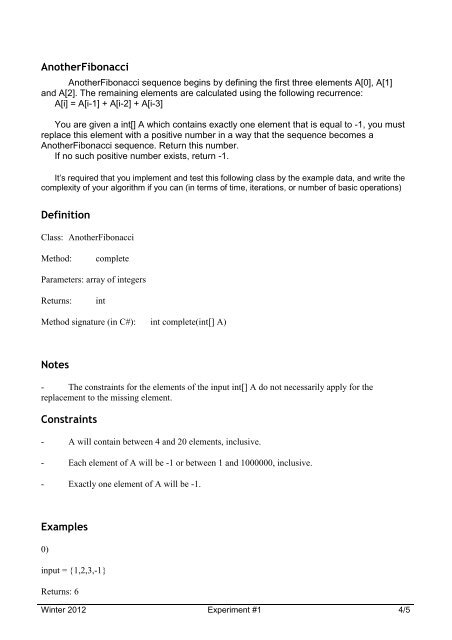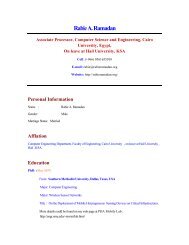Objectives Experiment #1 Introduction to Algorithms
Lab 1 - Rabie Ramadan
Lab 1 - Rabie Ramadan
Create successful ePaper yourself
Turn your PDF publications into a flip-book with our unique Google optimized e-Paper software.
AnotherFibonacci<br />
AnotherFibonacci sequence begins by defining the first three elements A[0], A[1]<br />
and A[2]. The remaining elements are calculated using the following recurrence:<br />
A[i] = A[i-1] + A[i-2] + A[i-3]<br />
You are given a int[] A which contains exactly one element that is equal <strong>to</strong> -1, you must<br />
replace this element with a positive number in a way that the sequence becomes a<br />
AnotherFibonacci sequence. Return this number.<br />
If no such positive number exists, return -1.<br />
It’s required that you implement and test this following class by the example data, and write the<br />
complexity of your algorithm if you can (in terms of time, iterations, or number of basic operations)<br />
Definition<br />
Class: AnotherFibonacci<br />
Method:<br />
complete<br />
Parameters: array of integers<br />
Returns:<br />
int<br />
Method signature (in C#): int complete(int[] A)<br />
Notes<br />
- The constraints for the elements of the input int[] A do not necessarily apply for the<br />
replacement <strong>to</strong> the missing element.<br />
Constraints<br />
- A will contain between 4 and 20 elements, inclusive.<br />
- Each element of A will be -1 or between 1 and 1000000, inclusive.<br />
- Exactly one element of A will be -1.<br />
Examples<br />
0)<br />
input = {1,2,3,-1}<br />
Returns: 6<br />
Winter 2012 <strong>Experiment</strong> <strong>#1</strong> 4/5



